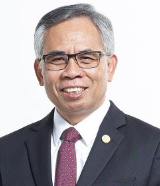If you cast your gaze over any recent banking crisis and look at what is left, one question worth asking is whether or not the regulators who cleaned up the multi-billion-dollar mess should allow those responsible, or their heirs, or even their loyal lieutenants, to remain involved in the financial industry.
That question is particularly pertinent in Asia where family-owned empires dominate commerce, and where it is common for the younger generations to defer to the elderly founder-patriarchs.
| Wimboh Santoso, OJK |
In the case of Indonesia, where the banking mess took years to clean up, it seems that’s fine. Just ask Wimboh Santoso, the 61-year-old head of Indonesia’s independent financial services authority, known as Otoritas Jasa Keuangan (OJK).
He says he doesn’t see any problem with the re-entry into Indonesian banking of the same business clans whose mismanagement of family-owned banks contributed to the collapse of the country’s economy two decades ago thanks to their flouting of basic banking rules, such as restrictions on related party transactions.
Three of the dynasties associated with banks that failed in the crisis are involved in new banks, as revealed by Asiamoney last year. Speaking with Asiamoney in an interview to mark Indonesia’s emergence from the 1997/98 Asia financial crisis, Santoso admitted he didn’t understand case-by-case what the issue was, and that it doesn’t matter because it is now a generation on from the 1990s.
“You are talking a different generation, actually,” Santoso says, “a different mentality. My view is that the person who was (then) in charge has disappeared… so it is totally different. I think the person who was (then) inside is not in the position (now).
Three of the most controversial corporate clans of old Suharto-era Indonesia – the Salims, the Riadys and the Widjajas – have taken control of three small Indonesian banks; Bank Ina Perdana, Bank Nobu and Bank Sinarmas, respectively, with ambitions to expand.
Each clan is well known in Indonesia for its role in the financial crisis. The Salims, Riadys and Widjajas respectively owned three of the country’s biggest failed banks in the late 1990s; Bank Central Asia, Lippo Bank and Bank Internasional Indonesia.
Each bank was taken over by the Indonesian state during the crisis-led restructuring of Indonesian banking in the late 1990s after revelations of massive intragroup lending, poor controls and mismanagement.
OJK’s Santoso claims there are ‘different generations’ at the helm of the three controversial clans’ new banks … but that is not so
Indeed, in the case of the Salims at BCA, such was the depth of official feeling toward them that, in 2002, the then-influential state enterprises minister Laksamana Sukardi said he would resign if the Salim family were allowed back at BCA.
A restructured BCA is now part of the Hartono family empire; the Hartonos, Indonesia’s richest family, made their fortune from the Djarum kretek cigarettes that are smoked across the archipelago.
Liem Sioe Liong aka Sudono Salim, the Salims’ late patriarch and founder-owner of BCA at the time of its 1998 seizure by the state, had also once been Indonesia’s richest man, his fortune also built in the clove market, which was parlayed into banking.
The Widjajas’ restructured Bank Indonesia Internasional is today the basis of Malaysian giant Maybank’s Indonesian operation, while the Riady family’s defunct Lippo Bank forms part of another Malaysia-owned Indonesian bank, CIMB Niaga.
Last year, Salim family head Anthoni Salim announced a $40 million deal to take control of Bank Ina Perdana, which marked the family’s first meaningful foray into the industry since control of BCA was lost in 1998. Anthoni Salim also has a small residual shareholding in BCA, believed to be less than 2%.
Disputed claims
The OJK’s Santoso claims there are “different generations” at the helm of the three controversial clans’ new banks, and the Salim-BCA presence at Bank Ina Perdana is limited. But that is not so at the Riadys’ new digital bank Nobu nor at the Widjajas’ Bank Sinarmas, where the board and senior management ranks of both banks are littered with former officials from the Widjajas’ BII and the Riadys’ Lippo.
Bank Sinarmas director Soejanto Soetjijo “began his career through the management development programme in Bank Internasional Indonesia in 1989,” the Bank Sinarmas website says.
Other former BII operatives at Bank Sinarmas include directors Hanafi Himawan, Heru Agus Wuryanto and Loa Johnny Mailoa.
Similarly, at Nobu Bank, directors Dewi Pandamsari, Tjindrasa Ng, Januar Angkawidjaja, Hendra Kurniawan and Lim Migi Trisnadi Elias are all former Lippo Bank employees or executives.
Still, this does not seem to concern the OJK’s Santoso, who has headed the seven-year-old authority since the middle of 2017.
“This generation is different,” he says. “You don’t see (Lippo patriarch) Mochtar Riady, a different generation actually. You see Sinar Mas, I think the fact that (family head) Eka Tjipta Widjaja is not there. I don’t know where he is now.”
A career central banker with Bank Indonesia, Santoso was studying for a masters in banking and finance at Britain’s Loughborough University when the 1997/98 crisis broke in Indonesia. In 2012, he joined the IMF as an executive director before he returned to Jakarta, where he became a director of the state-owned Bank Mandiri.


 Signal2forex.com - Best Forex robots and signals
Signal2forex.com - Best Forex robots and signals




